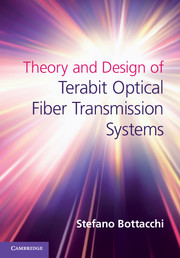Book contents
- Frontmatter
- Dedication
- Contents
- Preface
- Acknowledgments
- Part I Signals, spectra and optical modulations
- Part II Principles of light polarization and optical amplification
- Part III Interferometric optical modulators
- Part IV
- 13 Coherent system design for terabit transmission
- Appendix A Electromagnetic energy and power flow
- Appendix B Optical power and photon flux
- Index
- References
13 - Coherent system design for terabit transmission
Analysis and design of the dual-polarization coherent photoreceiver for quadrature optical modulation
from Part IV
Published online by Cambridge University Press: 05 September 2014
- Frontmatter
- Dedication
- Contents
- Preface
- Acknowledgments
- Part I Signals, spectra and optical modulations
- Part II Principles of light polarization and optical amplification
- Part III Interferometric optical modulators
- Part IV
- 13 Coherent system design for terabit transmission
- Appendix A Electromagnetic energy and power flow
- Appendix B Optical power and photon flux
- Index
- References
Summary
Introduction
This chapter concludes the book, introducing the theory and modeling of the dual-polarization intradyne coherent photoreceiver, suitable for quadrature optical modulation. “Intradyne” refers to a beating condition between two CW signals whose frequencies are neither equal (homodyne) nor too different (heterodyne), but close enough to be recognized and processed by a DSP unit.
The argument is definitely relevant to state-of-the-art optical fiber communications, and a more complete understanding of the several aspects would need at least a dedicated book. The intradyne coherent photoreceiver has been good news for the optical fiber transmission community since 2007, even if the necessary adaptation to new criteria and design procedures has demanded flexibility from industrial and research centers all over the world. The “coherent revolution,” as it is sometimes called, has drastically changed the fundamental rules governing optical fiber transmission systems design since 2007. Loss and dispersion equalization maps, lumped dispersion equalizers, dispersion compensating fibers (DCF), fiber Bragg gratings (FBG), polarization mode dispersion (PMD) compensators, fiber non-linearity, avalanche photodetectors and even erbium-doped fiber amplifiers (EDFA), distributed Raman amplification, and many other design tools and devices have gone through deep reassessment since 2007. Conversely, photonic integrated circuits (PIC) and digital signal processing (DSP) have gained major roles and today lead the new technology challenges in academic as well as industrial centers.
- Type
- Chapter
- Information
- Theory and Design of Terabit Optical Fiber Transmission Systems , pp. 1063 - 1265Publisher: Cambridge University PressPrint publication year: 2014
References
- 1
- Cited by



